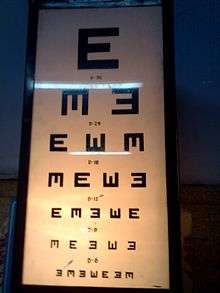E chart
An E chart, also known as a tumbling E chart, is an ophthalmological chart used to measure a patient's visual acuity.

A standard illuminated E chart
Uses
This chart is useful for patients who are unable to read the Latin alphabet – for example, very young children. It is also used in countries where people do not use the alphabet in their native language – for example, in China.
It contains rows of the letter "E" in various kinds of rotation. The patient is asked to state (usually by pointing) where the limbs of the E are pointing, "up, down, left or right." Depending on how far the patient can "read", his or her visual acuity is quantified. It works on the same principle as Snellen's distant vision chart.
gollark: And popularity.
gollark: It's new forum software and the public instance.
gollark: a.gh0.pw.
gollark: Probably not? They aren't a decorated combat veteran with marketing experience or whatever it is.
gollark: I don't think so?!
See also
References
- Basak, Samar K. Ophthalmology Oral and Practical (3rd ed.). ISBN 81-86793-66-6.
This article is issued from Wikipedia. The text is licensed under Creative Commons - Attribution - Sharealike. Additional terms may apply for the media files.